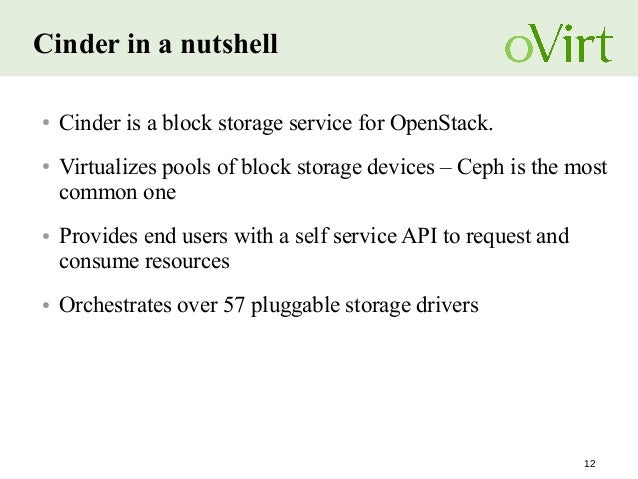The feature simplifies the installation of MS Windows on a VM when virtio disk and network drivers are used. OVirt provides a floppy with file Autounattend.xml which tells the installer where to find the necessary virtio drivers. Binary drivers are provided by some Linux distributions including WHQL Certified drivers. For example the binary drivers for Ubuntu can be found here. 64-bit versions of Windows Vista and newer (this currently includes Windows Server 2008, Windows 7, Windows 8, Windows Server 2008 R2 and Windows Server 2012) require the drivers to be digitally.
When installing a Windows server on oVirt, Inter-Network Interfaces ”,“e1000”and” Disks come as “IDE”. Otherwise, your server will not turn on. This also affects the performance of the machine. Therefore, you should do ”Network Interfaces”, “VirtIO” and “Disks”, “VirtIO-SCSI… Thus, your machine will operate at a smooth performance.
In order to do this configuration, you must install oVirt Guest Agent Driver (oVirt-toolsSetup) after installing the Windows server. You must first download the corresponding version of oVirt-tools-setup.iso (https://resources.ovirt.org/pub/ovirt-4.2/iso/oVirt-toolsSetup/), mount it as a CD Drive, and then perform the typical * .exe installation… After the installation is finished,
Drivers Virtual Dj Sx3
Pull the network setting from e1000 to VirtIO.
Set the disk settings to VirtIO-SCSI from the IDE.


I hope it has been a useful article.

3.3.1. Red Hat Virtualization Guest Agents and Drivers
The Red Hat Virtualization guest agents and drivers provide additional information and functionality for Red Hat Enterprise Linux and Windows virtual machines. Key features include the ability to monitor resource usage and gracefully shut down or reboot virtual machines from the VM Portal and Administration Portal. Install the Red Hat Virtualization guest agents and drivers on each virtual machine on which this functionality is to be available.
Table 3.1. Red Hat Virtualization Guest Drivers
Ovirt Drivers
| Driver | Description | Works on |
|---|---|---|
| Paravirtualized network driver provides enhanced performance over emulated devices like rtl. | Server and Desktop. |
| Paravirtualized HDD driver offers increased I/O performance over emulated devices like IDE by optimizing the coordination and communication between the guest and the hypervisor. The driver complements the software implementation of the virtio-device used by the host to play the role of a hardware device. | Server and Desktop. |
| Paravirtualized iSCSI HDD driver offers similar functionality to the virtio-block device, with some additional enhancements. In particular, this driver supports adding hundreds of devices, and names devices using the standard SCSI device naming scheme. | Server and Desktop. |
| Virtio-serial provides support for multiple serial ports. The improved performance is used for fast communication between the guest and the host that avoids network complications. This fast communication is required for the guest agents and for other features such as clipboard copy-paste between the guest and the host and logging. | Server and Desktop. |
| Virtio-balloon is used to control the amount of memory a guest actually accesses. It offers improved memory overcommitment. | Server and Desktop. |
| A paravirtualized display driver reduces CPU usage on the host and provides better performance through reduced network bandwidth on most workloads. | Server and Desktop. |
Table 3.2. Red Hat Virtualization Guest Agents and Tools
Drivers Overtime
| Guest agent/tool | Description | Works on |
|---|---|---|
| Allows the Red Hat Virtualization Manager to receive guest internal events and information such as IP address and installed applications. Omnivision usb devices driver downloads. Also allows the Manager to execute specific commands, such as shut down or reboot, on a guest. Quantitative imaging 1394 driver download for windows 10. On Red Hat Enterprise Linux 6 and later guests, the ovirt-guest-agent-common installs | Server and Desktop. |
| Used instead of | Server and Desktop. |
| The SPICE agent supports multiple monitors and is responsible for client-mouse-mode support to provide a better user experience and improved responsiveness than the QEMU emulation. Cursor capture is not needed in client-mouse-mode. The SPICE agent reduces bandwidth usage when used over a wide area network by reducing the display level, including color depth, disabling wallpaper, font smoothing, and animation. The SPICE agent enables clipboard support allowing cut and paste operations for both text and images between client and guest, and automatic guest display setting according to client-side settings. On Windows guests, the SPICE agent consists of vdservice and vdagent. | Server and Desktop. |
| An agent that enables users to automatically log in to their virtual machines based on the credentials used to access the Red Hat Virtualization Manager. | Desktop. |
